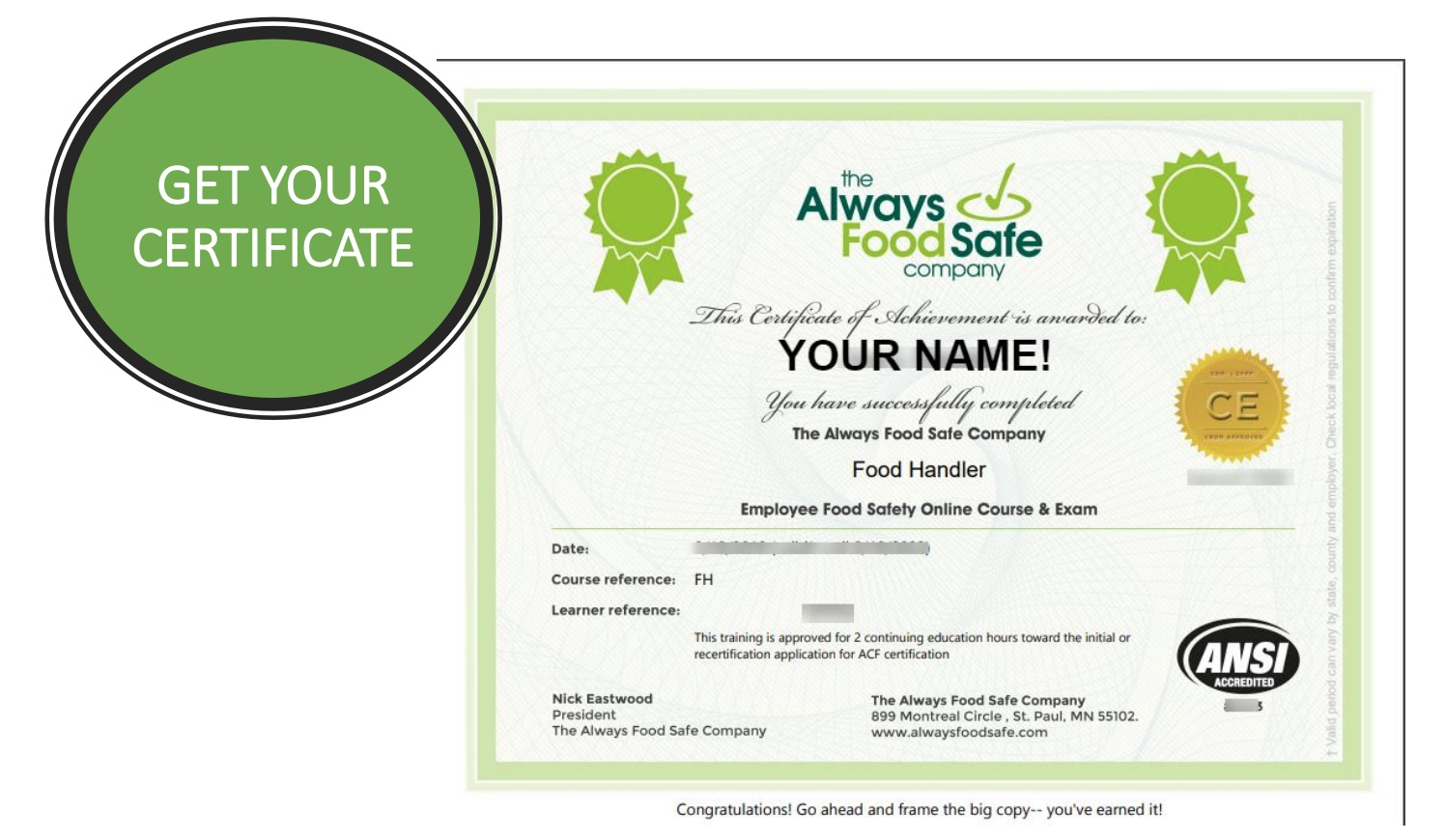How to Earn Your Food Handler Certification for Restaurant Compliance
How to Earn Your Food Handler Certification for Restaurant Compliance
Blog Article
Your Guide to Food Handler Qualification-- Protect Public Health
Food Handler Accreditation is a crucial part in the realm of public wellness, guaranteeing that food service employees are geared up with essential understanding and practices to minimize foodborne disease threats. Understanding the qualification process, including its needs and ongoing education, is crucial for any expert in the food market.
Importance of Food Security
Food safety and security is crucial in the food solution sector, as it consistently safeguards public wellness and ensures the integrity of foodstuff. The value of keeping high standards in food security can not be overemphasized; it straight influences health outcomes, stopping foodborne health problems that can have extreme, sometimes fatal, consequences.

Moreover, in a progressively globalized food market, awareness of food security extends past neighborhood laws. Compliance with safety and security requirements is important to fulfill the expectations of both consumers and regulative firms. Failing to abide by these requirements can cause legal consequences, monetary loss, and damages to a facility's trustworthiness.
Inevitably, focusing on food safety is an essential obligation of all food solution drivers and staff members. By understanding and executing efficient food safety and security actions, the industry can considerably add to total public wellness and well-being.
Comprehending Accreditation Needs
Qualification requirements for food trainers are crucial to guarantee that individuals possess the required understanding and abilities to keep food safety standards. These needs vary by state or local jurisdiction, showing details wellness regulations and neighborhood requirements. Normally, people seeking accreditation needs to show competency in essential locations, consisting of proper food handling, storage methods, individual hygiene, and understanding foodborne health problems.
Conclusion of an identified food safety training program is usually a requirement. Such programs cover essential topics that furnish food trainers with the ability to stop contamination and make certain secure cooking. In addition, evaluations may be administered to review the prospect's understanding of the product.
Some jurisdictions may additionally need retraining or recertification after a specified period, guaranteeing that food handlers remain present with developing safety methods and guidelines. ServSafe Food Handler Card. This continuous education and learning is essential in adjusting to brand-new food security obstacles and keeping public wellness
It is crucial for food establishments to validate that their personnel holds legitimate qualifications, as conformity not just shields consumers yet also enhances the establishment's online reputation. Recognizing these certification demands is the primary step in the direction of fostering a culture of food safety and security within any organization.
Actions to Get Certification

Upon selecting a program, candidates need to enlist and complete the required training modules, which cover crucial topics such as foodborne ailments, risk-free food managing techniques, and health practices. After completing the training, individuals have to pass a qualification test that assesses their understanding of the product.
When the examination is effectively completed, candidates will certainly receive their food handler accreditation, which is normally valid for a specified period, frequently ranging from one to 5 years. Following these steps not only enhances individual expertise yet likewise adds to overall public health and safety and security in food service atmospheres.
Common Food Safety Practices
Comprehending food security techniques is essential for anyone functioning in the food service sector. Food handlers should clean their hands thoroughly with soap and water prior to and after taking care of food, especially after using the restroom or touching raw active ingredients.
An additional crucial practice is the proper storage space of food items. Perishable foods need to be her comment is here kept at suitable temperature levels to inhibit bacterial development, while completely dry items need to be kept in a tidy, dry setting. Cross-contamination should likewise be avoided; this involves utilizing separate tools and reducing boards for raw and prepared foods to stop dangerous virus from moving.
Food handlers ought to be conscious of the value of correct food labeling and expiry days to decrease waste and make certain the safety and security of the food being served. Sticking to these usual food safety and security techniques is essential for protecting public health.


Preserving Your Certification
Preserving food trainer certification is necessary Related Site for guaranteeing continuous conformity with food safety criteria in the food service market. Qualification generally needs revival every three to five years, relying on neighborhood policies. It is vital for food trainers to remain knowledgeable about the specific renewal timeframe mandated by their state or neighborhood health department.
To preserve accreditation, food trainers must take part in constant education and learning. This can consist of attending workshops, seminars, or on the internet courses that cover new food security methods and guidelines. Remaining informed about emerging fads, such as irritant management and cross-contamination prevention, is vital.
Additionally, practical experience plays a significant duty in keeping accreditation. Food handlers should continually use the understanding acquired through their training in their day-to-day procedures. On a regular basis examining food security protocols with employee can strengthen best techniques within the organization.
Conclusion
Finally, food trainer certification plays a vital function in protecting public wellness by furnishing individuals with crucial understanding and skills to stop foodborne health problems. Abiding by correct food safety techniques not only makes certain conformity with regulatory criteria however likewise boosts the track record of food establishments. Routine renewal and constant education better strengthen expertises within the food service market. Inevitably, a trained labor force adds significantly to a more secure dining experience for customers and the total honesty of food safety and security.
Qualification needs for food trainers are vital to ensure that people have the essential understanding and skills to maintain food safety requirements.Acquiring food handler accreditation includes a collection see this site of organized actions created to make sure that people satisfy the needed requirements of food security expertise and techniques.Recognizing food safety and security techniques is essential for any person functioning in the food solution market. Food handlers need to be aware of the importance of proper food labeling and expiry days to lessen waste and make sure the security of the food being served.Maintaining food trainer qualification is crucial for guaranteeing ongoing compliance with food safety and security requirements in the food service industry.
Report this page